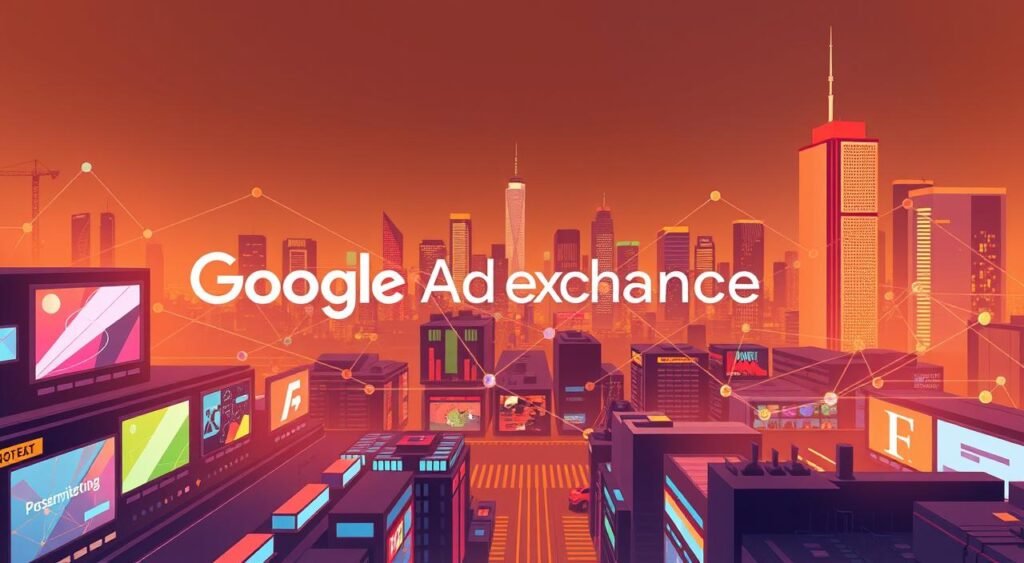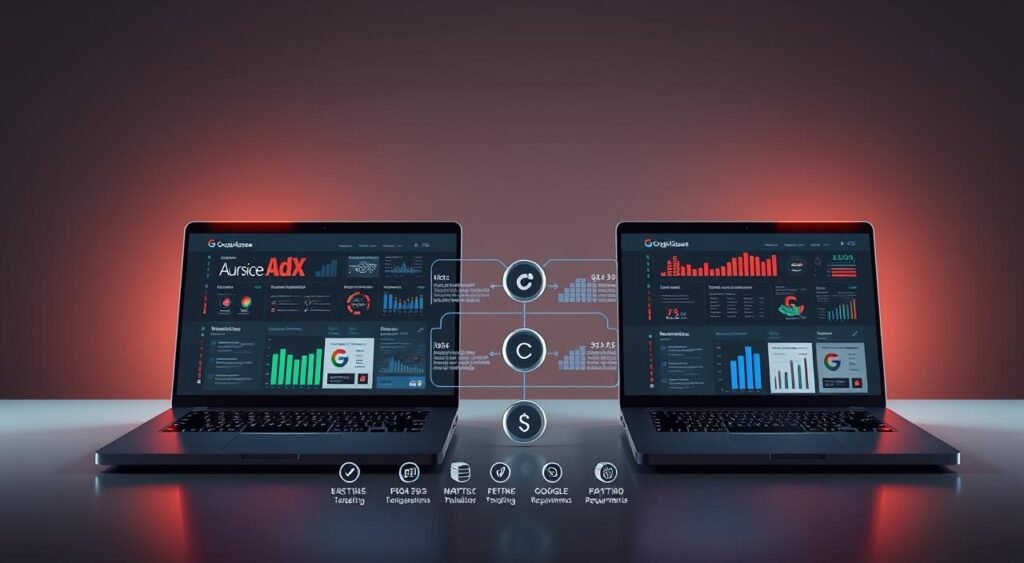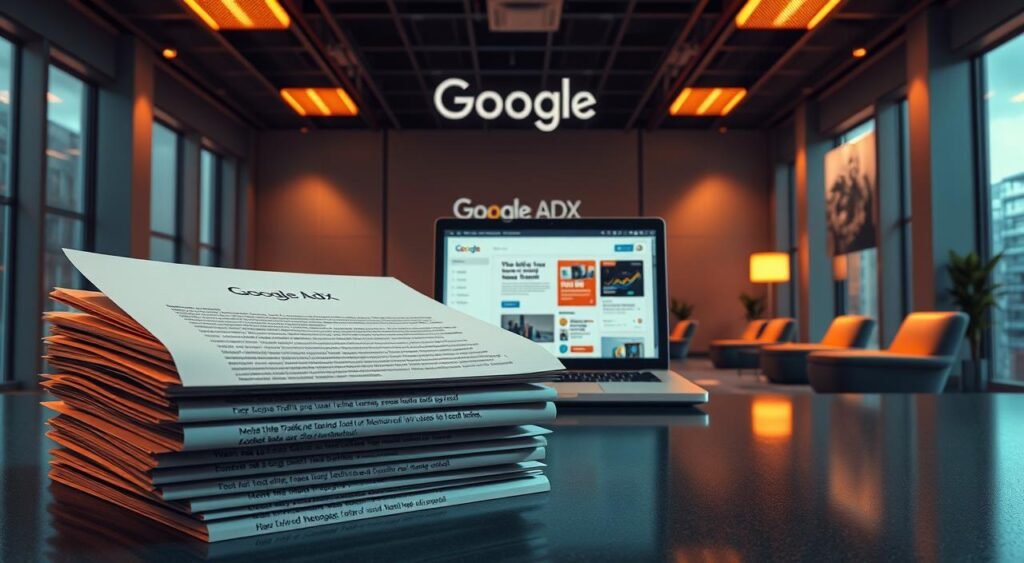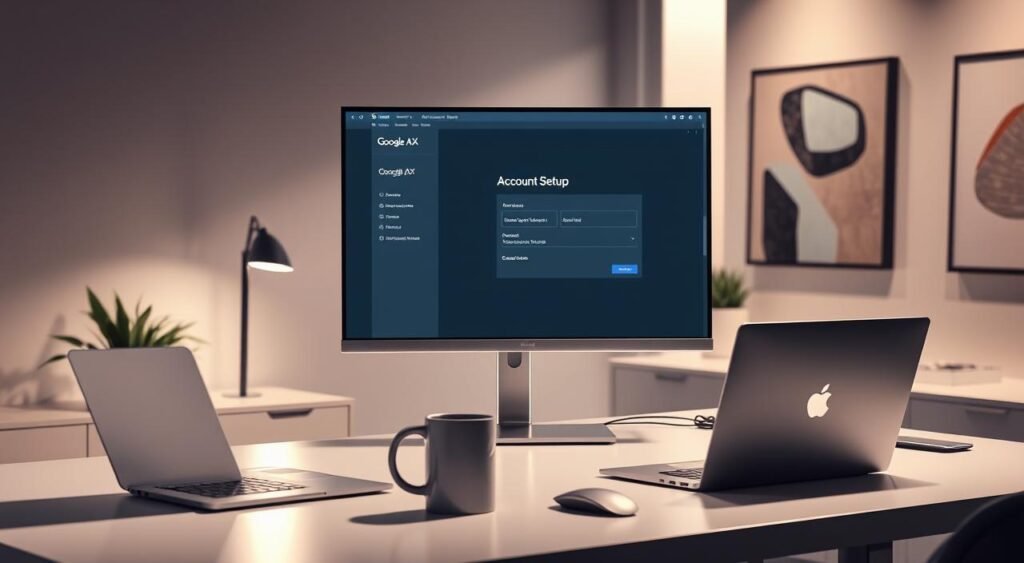Digital advertising has seen a significant shift with Google Ad Exchange (Google AdX). This marketplace is changing how digital ad inventory is traded in real time. It’s a premium platform for programmatic advertising, connecting publishers and advertisers through advanced tech.
To grasp what Google AdX is, we must understand its role in digital advertising. Google acquired it in 2008, transforming it from DoubleClick Ad Exchange. Now, it’s a key tool for digital marketing pros, aiming for efficient and clear ad solutions.
Simply put, Google Ad Exchange is an online marketplace. Here, publishers can sell their ad space to many buyers at once. Unlike traditional networks, AdX uses real-time bidding. This means ads are sold instantly, thanks to complex algorithms and user data.
This platform offers publishers more control over their ad space. At the same time, it gives advertisers access to top-quality digital ad spaces. It’s built on advanced tech, ensuring maximum revenue and targeted ad strategies.
Understanding Google Ad Exchange Basics
The digital advertising world has seen a major shift with the rise of platforms like Google Ad Exchange. This advanced programmatic advertising marketplace has changed how publishers and advertisers trade digital ad space.

The introduction of the doubleclick ad exchange was a game-changer in online ads. It gave publishers more control over their online space. This allowed them to increase their earnings through smart, automated sales methods.
From DoubleClick to Modern AdX
Google’s buy of DoubleClick in 2007 was a turning point for digital ads. The platform grew from a basic ad server to a full-fledged programmatic marketplace. It now offers advanced targeting and optimization features.
Core Platform Functions
Google Ad Exchange provides publishers with key tools for managing their ad space. Real-time bidding allows for fast auctions, letting advertisers bid on top ad spots in seconds. This fast-paced system ensures the best prices and highest earnings for digital publishers.
Programmatic Advertising Significance
Google Ad Exchange is a key part of today’s digital ads. It simplifies complex deals. Advertisers get access to top-quality ad space, and publishers use smart ways to make money that keep up with market changes.
What Is Google AdX?

Google AdX is a cutting-edge platform for premium ad inventory, revolutionizing digital advertising for both publishers and advertisers. It offers a programmatic solution that maximizes digital real estate. This is achieved by connecting high-quality publishers with top-tier advertisers through a sophisticated marketplace.
At its essence, Google AdX is a digital advertising exchange. It empowers publishers to sell their ad space directly to advertisers through real-time bidding. This contrasts with traditional ad networks, providing publishers with detailed control over pricing, targeting, and inventory management.
The platform excels by providing publishers with advanced tools to boost their advertising revenue. They can set custom pricing rules, select which advertisers can access their inventory, and implement sophisticated targeting strategies. This level of control sets Google AdX apart from simpler solutions like AdSense.
Digital publishers from various sectors, including media and niche content, can use this platform to enhance their revenue. Google AdX supports a range of ad formats, including display, video, and mobile ads. This makes it a flexible solution for today’s digital publishing landscape.
The platform’s advanced algorithms and vast network of advertisers help publishers achieve their revenue goals. They do so while maintaining high standards of advertising quality.
How Google Ad Exchange Works
Google Ad Exchange is a cutting-edge digital marketplace. It allows publishers to sell ad inventory through adx efficiently. This platform revolutionizes digital advertising by linking publishers and advertisers through advanced technology.

The heart of Google Ad Exchange is its real-time bidding (RTB) technology. This system enables fast ad space transactions. Advertisers compete for digital space in mere milliseconds.
Real-Time Bidding Mechanics
Advertisers bid competitively for ad impressions in real-time. The highest bidder wins the ad space. This ensures publishers get the most value and advertisers reach their target audience effectively.
Auction Variations
Google Ad Exchange features three main auction types: open auctions, private auctions, and preferred deals. Each offers unique benefits for publishers aiming to enhance their digital ad strategies and boost revenue.
Pricing Structures
Pricing in Google Ad Exchange is influenced by ad quality, relevance, and bidding competition. Publishers can use these complex pricing models to develop more effective monetization strategies for their digital platforms.
Key Benefits of Using Google AdX

Publishers aiming to boost their digital ad earnings find Google AdX a top choice. It stands out from traditional networks with its advanced features. These features revolutionize how publishers approach digital advertising.
Google AdX’s main strength is its ability to generate revenue. It gives publishers more control over their ad space and pricing. This allows for more detailed strategies to boost ad income.
AdX also excels in targeting, helping publishers connect with the right advertisers. Its sophisticated algorithms ensure ads are shown to the most relevant audiences. This boosts click-through rates and ad performance, opening doors to a wider range of premium advertisers.
Transparency is another key benefit of Google AdX. It offers detailed reports and insights, helping publishers understand their ad performance. They can track metrics in real-time, analyze revenue trends, and make informed decisions to enhance their ad campaigns.
Google AdX also comes with powerful programmatic advertising tools. These tools help publishers make the most of their digital space. The platform’s flexibility and advanced features make it a great choice for websites looking to increase their ad revenue.
Google AdX vs Google AdSense: Understanding the Differences
Digital publishers face critical choices when selecting advertising platforms. The comparison between Google AdX and Google AdSense reveals significant distinctions that can impact website monetization strategies.

Choosing between Google AdX and AdSense depends on multiple factors. While AdSense provides an accessible entry point for smaller publishers, Google AdX offers more sophisticated monetization opportunities for established websites.
Revenue Generation
Google AdX typically generates higher revenue compared to AdSense. The platform connects publishers with premium advertisers through advanced programmatic advertising techniques. Publishers with substantial traffic can leverage AdX’s complex bidding mechanisms to maximize their ad revenue.
Publisher Control and Flexibility
AdX provides publishers with greater control over ad inventory. The platform allows more granular settings for ad placements, pricing rules, and targeting options. Publishers using AdX can implement more strategic approaches to managing their digital advertising ecosystem.
Eligibility Requirements
Adx publisher requirements are significantly more stringent than AdSense. Websites must typically demonstrate substantial traffic, with minimum thresholds around 5 million monthly pageviews. Publishers need to meet Google’s quality standards and maintain a professional digital presence to qualify for Google AdX access.
Understanding these differences helps publishers make informed decisions about their digital advertising strategies. This ensures optimal revenue generation and platform alignment.
Requirements for Joining Google AdX

To enter the Google Ad Exchange (AdX) marketplace, publishers must meet certain standards. These requirements ensure the quality of digital advertising. Publishers need to show they have substantial website traffic and high-quality content to qualify.
Joining Google AdX requires at least 5 million pageviews monthly. This shows Google that a publisher has a large digital presence with engaged audiences. Websites must also have brand-safe content, avoiding controversial or inappropriate material.
To become a Google authorized seller, publishers must take several steps. They need an updated ads.txt file to validate their advertising inventory. Google also checks ad viewability, content safety, and website integrity before granting access to AdX.
For publishers not meeting the pageview requirements, there are alternative routes. Working with certified Google AdX partners can provide access to this premium advertising ecosystem. These partners help smaller publishers meet the complex requirements and gain entry to the platform.
Understanding these requirements helps publishers prepare their digital properties for Google AdX. They should focus on creating high-quality content, maintaining robust website traffic, and ensuring advertising transparency. These steps are essential for becoming an approved Google authorized seller.
Setting Up Your Google AdX Account
Entering the Google Ad Exchange realm demands careful planning and technical savvy. Publishers aiming for top digital ad earnings must meticulously set up their accounts. This process is about building a strong platform for programmatic ad success.

Setting up a Google AdX account requires precision and a keen eye for detail. The initial step is linking your account with Google Ad Manager. This is your main tool for managing your ad space.
Integration with Google Ad Manager
Integration success hinges on verifying your site meets Google’s quality benchmarks. As an authorized seller, you must show high-quality content, a clean site, and steady traffic. This verification ensures the ad ecosystem’s integrity.
Technical Implementation Steps
Setting up your AdX account involves several technical steps. You’ll need to create unique ad units, set up pricing rules, and track performance. Key tasks include adding Google’s ad tags to your site and setting up header bidding to boost earnings.
Account Configuration Best Practices
To optimize your Google Ad Exchange account, plan strategically. Focus on placing ads effectively, setting competitive prices, and monitoring performance. Regularly optimizing your account is key to high earnings and a great user experience.
Optimizing Ad Revenue Through Google AdX

Publishers can significantly boost their digital ad earnings by adopting strategic methods for AdX. Achieving maximum revenue demands a complex strategy, extending beyond simple ad placement.
Identifying and utilizing high-value ad spots across your digital platforms is key. Analyze your site’s layout, user behavior, and content to pinpoint the best spots for premium ads.
Advanced optimization techniques can significantly enhance AdX performance. Header bidding stands out as a powerful tactic to boost ad inventory value. It allows multiple exchanges to bid simultaneously, increasing the worth of your ad spaces.
Dynamic pricing is another advanced strategy. It uses smart algorithms to adjust floor prices based on market demand in real-time. This ensures you capture the highest possible revenue for each impression.
Using AdX’s detailed reporting and analytics tools is essential for optimization. These tools provide insights into which strategies yield the most revenue. This allows for data-driven improvements in your ad strategy.
Successful ad monetization is a continuous cycle of testing, measuring, and adjusting. By continually refining your AdX approach, you can unlock substantial revenue opportunities.
Working with Authorized Buyers
Google Ad Exchange empowers publishers to tap into a vast network of demand partners. This platform maximizes digital advertising revenue. It offers access to a premium ad inventory ecosystem, revolutionizing digital advertising monetization.

Understanding the various demand partners is key. Ad networks, trading desks, demand-side platforms (DSPs), and direct advertisers are the backbone of this complex marketplace.
Types of Demand Partners
Google authorized sellers interact with a range of demand partners. Trading desks manage programmatic media buying for agencies. DSPs automate ad purchases across various inventory sources. Direct advertisers offer targeted campaigns, potentially leading to higher revenue.
Building Advertiser Relationships
Building strong connections with demand partners is essential. Publishers must maintain high-quality inventory and engage audiences reliably. Transparency, consistent performance, and adherence to Google’s guidelines are vital for trust.
Effective management of relationships with authorized buyers boosts revenue and ensures long-term success in digital advertising.
Advanced Features and Tools in Google AdX
Google Ad Exchange introduces sophisticated tools that revolutionize the programmatic advertising landscape for publishers. These advanced features allow digital advertisers to enhance their ad inventory performance. They also enable them to reach targeted audiences more effectively.
Private marketplace deals are a key capability within the premium ad inventory platform. Publishers can create exclusive advertising environments. Here, select advertisers get priority access to high-quality ad spaces. This method offers more controlled and strategic ad placements than traditional open marketplace models.
Programmatic guaranteed deals offer another innovative solution for publishers. These deals allow direct negotiations with specific advertisers. They ensure predetermined inventory allocation at fixed prices. The real-time bidding technology in Google AdX makes these transactions seamless and efficient.
Advanced audience targeting options are a critical feature. Publishers can use detailed demographic, behavioral, and contextual data. This data helps match advertisers with precise audience segments. Such precision increases ad relevance and can drive higher engagement rates.
Inventory forecasting and real-time reporting tools provide publishers with unparalleled visibility into their ad performance. These analytics help optimize pricing strategies and identify revenue opportunities. They enable publishers to make data-driven decisions within the programmatic advertising marketplace.
Common Challenges and Solutions
Publishers often face complex challenges when using Google Ad Exchange. These issues can affect their digital advertising performance. It’s essential to understand these obstacles to effectively sell ad inventory through adx and increase revenue.
When publishers explore platforms like Google Ad Exchange, they encounter technical and strategic hurdles. Ad discrepancies, low fill rates, and quality control issues can disrupt advertising workflows significantly.
Identifying Critical Performance Bottlenecks
To resolve ad inventory challenges, a systematic approach is needed. Publishers must analyze fill rates and examine ad placement strategies. They also need to ensure their technical infrastructure supports seamless ad delivery. Implementing precise targeting configurations helps mitigate performance inconsistencies.
Optimization Strategies for Better Results
Successful publishers use advanced diagnostic tools within Google Ad Exchange to identify and resolve issues. Key optimization techniques include improving website loading speeds and refining audience segmentation. They also focus on maintaining high-quality ad placements to attract premium advertisers.
Quality Control and Monitoring
Proactive monitoring of ad performance metrics is vital for publishers. It allows them to quickly identify and address problems. Using built-in AdX reporting features helps track revenue, engagement, and technical interruptions in real-time.
Best Practices for Publishers
Creating a successful strategy on Google Ad Exchange requires careful attention to multiple aspects of digital advertising. Publishers seeking to maximize their high-value ad space must focus on developing robust content strategies. These strategies should attract quality traffic and engage audiences effectively.
Quality content remains the foundation of a premium ad inventory platform. Publishers should prioritize creating original, relevant, and valuable content that meets user needs. This approach not only attracts more visitors but also increases the attractiveness of ad spaces to advertisers.
Ad placement optimization is key for maximizing revenue. Strategic positioning of ads can significantly improve visibility and click-through rates. Experiment with different ad locations, but avoid overwhelming users with too many advertisements. The goal is to create a balanced user experience that maintains engagement while generating revenue.
Regular performance monitoring helps publishers refine their advertising strategy. Utilize Google Ad Exchange analytics to track key metrics such as fill rates, revenue per thousand impressions (RPM), and user engagement. These insights enable publishers to make data-driven decisions about ad configurations and content strategies.
Compliance with Google AdX policies is non-negotiable. Stay updated on platform guidelines, industry regulations, and privacy standards. This proactive approach ensures continued access to the premium ad inventory platform and protects against account restrictions.
Technical optimization cannot be overlooked. Ensure websites are mobile-friendly, load quickly, and provide a seamless user experience across different devices. These technical considerations directly impact the value of your high-value ad space and overall advertising performance.
Future Trends in Programmatic Advertising
The programmatic advertising landscape is rapidly evolving, driven by technological advancements and shifting digital environments. Publishers and advertisers must stay ahead of emerging trends to optimize their digital advertising strategies.
Artificial Intelligence Transforming Ad Ecosystems
Artificial intelligence is revolutionizing the ad ecosystem. Machine learning algorithms are becoming more advanced, enabling precise audience targeting and real-time optimization. These advancements allow advertisers to deliver more personalized and relevant ad experiences.
Connected TV and Emerging Advertising Channels
Connected TV advertising is a significant growth area in the programmatic advertising market. As streaming platforms grow, advertisers are developing more sophisticated strategies to reach audiences across various digital channels. This shift necessitates advanced programmatic technologies that can seamlessly integrate traditional and emerging media platforms.
Privacy-Driven Data Strategies
With rising privacy regulations, first-party data has become essential. Digital advertising platforms are adapting by developing more transparent and consent-based data collection methods. Publishers must prioritize user privacy while maintaining effective targeting capabilities.
The future of programmatic advertising will require continuous innovation, adaptability, and a deep understanding of technological trends and user expectations.
Conclusion
Google AdX is a cutting-edge digital advertising platform that revolutionizes how publishers monetize their online spaces. It’s an advanced programmatic advertising marketplace that empowers publishers to boost their revenue through smart, real-time bidding. The Google Ad Exchange explained in simple terms gives publishers unmatched control over their digital ad inventory.
Publishers looking into Google AdX will find a powerful ecosystem for optimizing ad performance. The platform offers advanced tools for targeting, pricing, and managing digital ads across various channels. By using cutting-edge auction technologies and a wide range of demand partners, publishers can tap into higher revenue streams than traditional methods.
As programmatic advertising keeps evolving, Google AdX stays at the edge of digital marketing innovations. Publishers who adopt best practices, meet platform requirements, and keep up with new technologies will thrive. The future of digital ads calls for adaptable, intelligent solutions, which Google Ad Exchange consistently provides.
Implementing Google AdX strategically can revolutionize digital advertising for publishers aiming for more advanced monetization strategies. With its wide range of features, extensive advertiser networks, and ongoing technological enhancements, this platform is a strong option for publishers aiming to maximize their online ad revenue.
